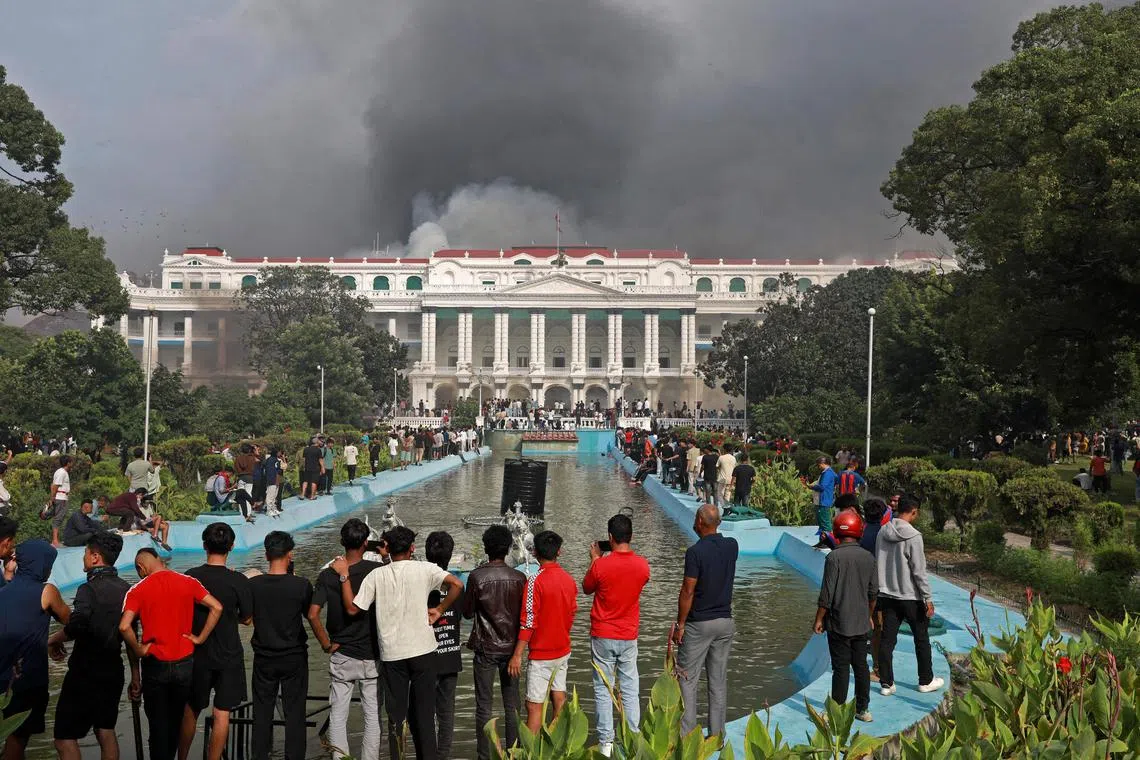Nepal’s social media ban backfires as citizens nominate new leader in chat room
Sign up now: Get ST's newsletters delivered to your inbox

Protesters gather at the Singha Durbar, the main administrative building for the Nepal government, in Kathmandu on Sept 9.
PHOTO: AFP
Pranav Baskar
Follow topic:
KATHMANDU - An attempt to ban social media in Nepal ended this week in violent protests with the prime minister ousted,
Now, the very technology that the government tried to outlaw is being harnessed to help select the country’s next leader, as more than 100,000 citizens are meeting regularly in a virtual chat room to debate Nepal’s future.
More than 30 people were killed in clashes with the police
With the country in political limbo and no obvious next leader in place, Nepalis have taken to Discord, a platform popularised by video gamers, to enact the digital version of a national convention.
“The Parliament of Nepal right now is Discord,” said Mr Sid Ghimiri, 23, a content creator from Kathmandu, describing how the site has become the centre of the nation’s political decision-making.
The conversation inside the Discord channel, taking place in a combination of voice, video and text chats, is so consequential that it is being discussed on national TV and live-streamed on news sites.
The channel’s organisers are members of Hami Nepal, a civic organisation, and many of those participating in the chat are the so-called Gen Z activists who led this week’s protests.
But since Prime Minister K.P. Sharma Oli’s abrupt resignation on Sept 9, power in Nepal effectively resides with the military. The army’s chiefs, who most likely will decide who next leads the country, have met the channel’s organisers and asked them to put forth a potential nominee for interim leader.
Among the names being discussed in the channel were Mr Sagar Dhakal, a one-time political candidate, and Mr Kul Man Ghising, former director of Nepal’s electricity authority. The two men participated in an hours-long meeting in the chat room on Sept 10, according to three people familiar with the call.
By the end of Sept 10, they said, after lengthy discussions and several polls, the Discord group had coalesced around Ms Sushila Karki, a former chief justice, and proposed her name for in-person meetings with the country’s army.
And on Sept 9, Ms Karki met Nepal’s President Ram Chandra Poudel and army chief Ashok Raj Sigdel, according to the Discord channel organisers. Ms Karki’s lawyer did not respond to a request for comment.
“The point was to simulate a kind of mini-election,” said Mr Shaswot Lamichhane, a channel moderator who helped establish the server and has represented the group in meetings with the military. Mr Lamichhane graduated from high school a few months ago.

Nepali army personnel at a roadblock after days of riots and political upheaval in Kathmandu on Sept 11.
PHOTO: ATUL LOK/NYTIMES
The Discord group, he said, did not represent the whole country, and its goal was only to suggest an interim leader who could oversee elections. In just four days, the server has grown to more than 145,000 members. And users are quickly discovering both the limits of democracy and of a social media platform in which everyone gets a say.
“It happened so quickly,” said Mr Samdip Yadav, 23, a recent college graduate in Kathmandu, who joined parts of Sept 10’s forum.
“We do not have definite leaders to represent us,” he added, calling the channel’s discussions “very disorganised”, which at times felt like a “random social media call”.
The chat history of the server is a reflection of that disorder and infighting. Anyone can join the channel, making it easily infiltrated by trolls or people from outside Nepal. Moderators have had to tamp down calls for violence. And because anyone can speak up, conversations are often a garbled mess of unidentifiable voices.
The organisers have had to choose between supporting a freewheeling discussion and quickly agreeing on a representative to meet the army. The Gen Z group is competing with groups outside the Discord server that are also jockeying for influence. “Please decide on a representative right now – we do not have time,” the moderators told the channel on Sept 10 before settling on Ms Karki.
Among those also in talks with the military are representatives of some Nepali political parties and supporters of the former monarchy. NYTIMES

